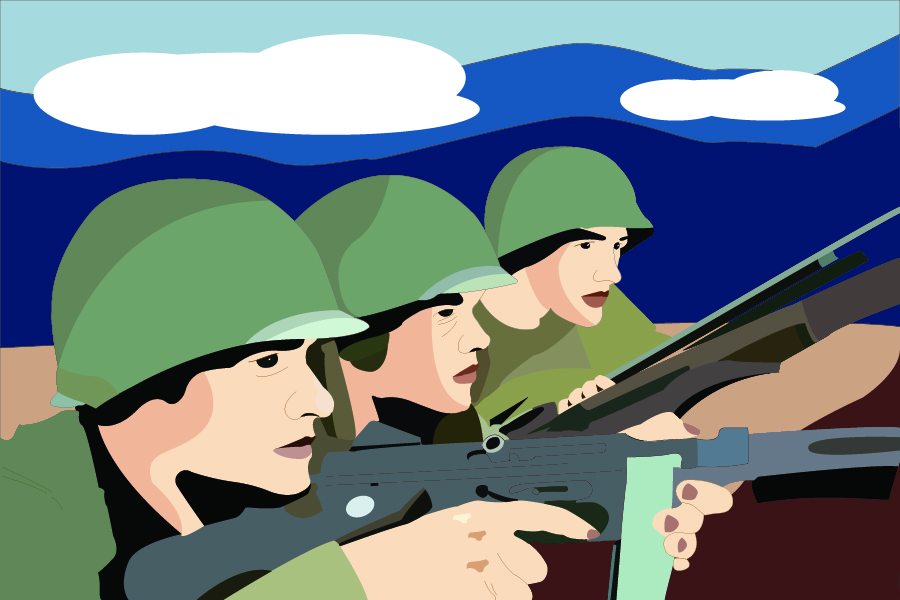
Movies must avoid glorifying war and instead show the damage they do to humanity
 Twelve years ago, I stumbled upon the movie “Saving Private Ryan” on television and figured that I could watch it. It seems rather bad for an 8 year old to watch people get their legs blown off. But since I liked history so much, I figured watching this would be interesting from an educational perspective.
Twelve years ago, I stumbled upon the movie “Saving Private Ryan” on television and figured that I could watch it. It seems rather bad for an 8 year old to watch people get their legs blown off. But since I liked history so much, I figured watching this would be interesting from an educational perspective.
Watching this violent film encouraged me to watch other war films as well. For a long time, I watched these movies just to see all the blood and the fighting.
I’m sure I’m not the only one to say that action films with a lot of violence can be very appealing. Before, I thought that the movie “The Thin Red Line” was bad just because I skipped through the whole movie and found that there were only two combat scenes. I read all the comments on YouTube and wondered why people thought it was such a good film.
So this got me thinking about a big question — what makes a war film “good?” I watched movies like “Platoon” and “Black Hawk Down,” and for a very long time, I felt that a good war movie just had to have advanced special effects to be as realistic as possible.
Despite the gut spilling and other realistic effects that made war seem absolutely miserable, these movies made me see war as this interesting setting to potentially take part in. They made war seem fun. For a long time, I had this fanciful image of what war was actually like. We’re not just talking about young kids playing war. Young and old can watch these movies with soldiers shooting down enemies and wonder, “Why can’t I do that?” That is why every year, tens of thousands of people meet up all over the country and reenact wars.
Ordinary people, from your barber to five-star generals, have a bloodthirsty desire to go to war and bomb other people. This is one of the untold consequences of portraying war in such a romanticized way — by focusing on the physical aspect of war and not its emotional toll.
The suffering of soldiers is often only shown through physical pain on the big screen. But in reality, a soldier may come home from a tour of duty in Iraq without a scratch but have a wrecked mental state after having absolutely horrifying experiences.
This is the part of warfare that movies largely do not display on the big screen. A movie with plenty of action scenes, big budgets and big-name actors is likely to make much more money than one that shows very little blood and only short combat scenes. These days, it seems that historical war films either need a lot of blood and guts or some type of love angle to get tens of millions of dollars in the box office.
That’s the problem that many movies have. They have to decide between portraying war in stark circumstances, making it too boring or off-putting for the average movie-goer, or make it like any other action movie and add plenty of gore and other special effects to keep the heart racing.
That’s not to say that all war movies out there are completely bad. Many films glorify war and make it seem honorable to die in battle while portraying it how it actually is — grim, disgusting, harrowing, mentally jarring and absolutely miserable. A realistic war film can have good special effects while also taking into account what war does to humanity. It’s very hard to show how war damages a person’s mental state. But it’s not impossible.
Oliver Stone wrote the film “Platoon,” which was based upon his own experiences as a soldier in Vietnam. One of the most striking scenes in that film comes when the soldiers burn down a Vietnamese village. The horror and disgust on the soldiers’ faces about what they just did hint at the regret of doing such a horrible thing. Death is just one side to war. The audience didn’t have to see the suffering of the civilians to know how they felt about it.
At times, the film does glorify war, especially with the combat scenes and the Rambo-like behavior of Charlie Sheen’s character. But this film did a very good job demonstrating that war affects everyone and it’s an utter shame that people have to be put through it. Whether it be the soldier suffering from seeing his best friend die right in front of him or the mother who saw her child murdered by soldiers for no reason, the less “entertaining” parts of war have to be shown on the big screen.
I want to recommend two World War II films that are relatively unknown. The first one is an Italian film called “El Alamein,” named after a major battle in North Africa. The other is the 1993 German version of “Stalingrad,” named after the pivotal battle that changed the war. (“El Alamein: In the Line of Fire” can be found on Youtube. The only video on Youtube with the entire “Stalingrad” 1993 film is Russian-dubbed, but has English subtitles.)
Two aspects help make these movies some of the most accurate depictions of war. Both of these films are shown from a losing perspective, something often unheard of in war films, because writers think the audience wants to see a winner. They are also written in contrasting, extreme physical climates — one in the sweltering heat of the Egyptian desert, the other in the freezing open plains of Russia.
Gunfire, blood and all the other special effects aren’t really needed to make a good war film. It’s possible for film developers to create a realistic narrative even with a low budget and bad special effects.
Written by: Justin Chau — jtchau@ucdavis.edu
Disclaimer: The views and opinions expressed by individual columnists belong to the columnists alone and do not necessarily indicate the views and opinions held by The California Aggie.




